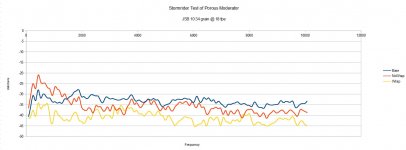OldSpook,
I would never claim to understand all the intricacies of how mufflers work. I have seen too many that did not work as well as expected; and a few that worked better. That said, I can come up with a reasonably functioning custom muffler most of the time.
As for side vents not having proven or disproven, the only evidence I have is anecdotal (not from a proper study - so that is a project that would be interesting to do). The anecdotal evidence involves taping off the vents, VS leaving them open. Besides, vents are not binary. The flow area of each vent and the total flow area have to be specified. Also, whether the vents are coupled directly to the inside of the can, or if some sort of dense fiber in occluding the flow - and how thick that fiber layer is; tamped down or not.
I find it instructive that most people advocating drilling holes in the rear of the shroud instruct their followers to stuff the end of the shroud with cotton wool, "to filter out lead dust, so you don't breath it". It is my contention that whatever improvement in sound that they perceive comes from the cotton wool, because if you remove that, the airgun is louder at your ear. So, the true believers should start with just the cotton wool; and leave their shrouds undrilled.
If you manage to flow enough air out the rear of a shroud or the sides of a muffler to reduce the report out the front, then you have increased the report towards the rear or sides. Some people have told me that they don't mind that, and only care about forward noise. Their choice.
In my opinion a dozen sub millimeter holes drilled in a muffler casing cannot flow enough air to make any difference in the 2 or 3 tenths of a second that the moderator is active, with the first tenth of a second being the one where most of the magic happens. Those vents do even less when obscured via fibrous material.
Gyroid infill is particularly interesting compared to cotton wool, because gyroid infill is open enough to accept air volume, it has many lossy flow passages, and acts as a poor sound reflector - all in one.
If you and
denovitch promote gyroid infill by means of sound improvement recordings and dB reduction data, DonnyFL and Hugget etc will eventually "have to" include it in their products, or fall out of fashion. Air gunners will soon be asking for it. And the good thing is gyroid infill actually works to improve airgun moderators. Unlike the pin striping that is a few rows of tiny vents.
I had a conversation with Gregor that started with corporate images, showing the Huben bullpup shroud with its vents at the front in some images, and in the rear in other images. The first question was where should the vents be, to be most useful. Gregor offered his opinion that when shooting at full power with the vented shroud "holy" at the rear, the airgun was louder to his ear. Yet that is where they are supposed to be. I interpret that as all the cool PCPs have shroud vents. Ditto for mufflers. So, if you want to compete in the market, you better have them. Style over substance.
I have been asked for variants of my muffler designs for the Huben pistol. The request are all about looking better, rather than sounding better. I have nothing against good looking designs, but not if it compromises function excessively; or in some cases, at all.
I realize that I am offering opinion based on facts, as I interpret them. You are free to mock me for that. In my opinion, you are helping me make my case. Manufacturers stamp in those vents. I want to stamp them out



